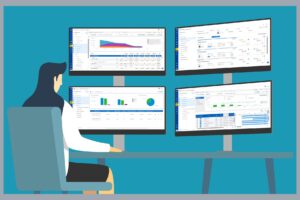- Home
- Blog Center
- Project Portfolio Dashboard: What to Include, Examples, Set-up
Project Portfolio Dashboard: What to Include, Examples, Set-up
Project Management Offices often oversee the centralized management of groupings of related projects and programs — in other words, portfolios. These portfolios may include a number of complex, high-stakes projects. Accordingly, it often proves challenging to get and maintain a clear and up-to-date view of activity at the portfolio level. That’s where project portfolio dashboards come into play. PPM dashboards shed light on the status and health of the projects in a portfolio, while also supporting planning and roadmapping activities. But when it comes to the tool itself, what should be included in a project portfolio dashboard?
Project Portfolio Dashboards: What Are They For?
A portfolio dashboard provides all concerned stakeholders with a high-level, one-page view of status and health indicators.
Project portfolio dashboards are typically used by project or business leaders who oversee multiple projects. This includes portfolio managers, IT directors, CxOs, PMOs, or other managers who want a high-level overview of performance. That said, they may also be used by Project or Program Managers when reporting to project owners and sponsors or to business stakeholders.
Visual collaboration
A portfolio dashboard consolidates various graphical reports, charts, and views as well as a range of key performance indicators to help track and measure project health, project progress, and budget information. It provides an at-a-glance view of the portfolio, helping you to understand:
- whether the projects are on track to timely and successful completion
- whether the actual performance matches the plans and expectations
- how the money is spent
- what problems or issues the portfolio might be facing
The goal is to facilitate and accelerate decisions regarding the portfolio and to enable managers to anticipate possible hurdles ahead of time in order to maximize the overall value of project-related activities for the organization.
Drilling down into the details
A good project portfolio dashboard should allow users to drill down into the details of specific projects. However, it is essentially designed to communicate higher-level insights about the portfolio as a whole.
Key Ingredients Of A Great Project Portfolio Dashboard
In the past, Project Portfolio Management professionals have used various methods to build portfolio dashboards — from pen-and-paper dashboards to specific developments based on Excel or other desktop tools.
However, these days, a Project Portfolio Dashboard usually takes the form of a dedicated module in a professional Project Portfolio Management platform.
Common features and capabilities
There is no absolute, one-size-fits-all standard when it comes to portfolio dashboards. That said, here are some of the features, capabilities, and views that most PPM software vendors provide:
- A portfolio timeline graph displaying the planned schedules of the projects and materializes connections, dependencies and progress (with visual emphasis on the projects falling behind schedule)
- Health indicators and graphs reflecting the operational and financial health of the portfolio and of the different projects it encompasses. These are often formatted as RAG (Red Amber Green) color indicators or heat maps.
- An overview of projects, budgets, and teams, with a summary of all projects
- Budget-specific indicators (e.g. budget vs. actual spend)
- Insights into present and planned utilization of resources
- The ability to assess the alignment of the portfolio with the strategic drivers and priorities of the organization
- An overview of outstanding issues, risks, and tasks by project and of unaddressed risks at the level of the portfolio
- The ability to share comments and notes, send notifications and see the granular level views of individual projects
What To Keep In Mind When Selecting Or Building A Portfolio Dashboard
As mentioned earlier, portfolio dashboards may come in different shapes and forms and include different sets of functionality. What should be included in a project portfolio dashboard in your organization really depends on your strategic and operational priorities, the type and size of your projects and portfolios, and on your PPM process.
However, when assessing various software offerings, make sure that the provided project portfolio dashboards meet certain key conditions:
- Usability. Your project portfolio dashboard will consolidate large masses of data, which various users (including non-operational and non-technical roles) will need to access and leverage. Hence, it is important to make sure that your dashboard is as intuitive and easy to use as possible.
- Customizability. Based on your organization’s culture and process and the information consumption habits of your staff and leadership, you may want to customize the views, navigation, and behavior of your dashboard to improve the overall user experience. Having a customizable, flexible, and scalable portfolio dashboard will also enable you to add extra features and reports should the need arise in the future.
- Dynamism. Change is inherent in Project Management. Ensure that the project portfolio dashboard of your choosing can update the data in real-time.
Read more about PPM:
Share the article
Related content






